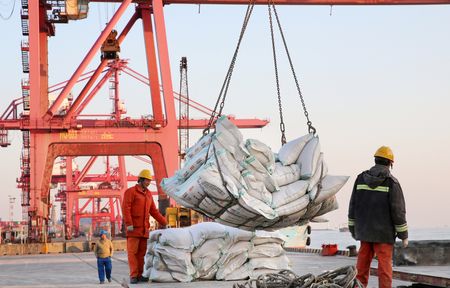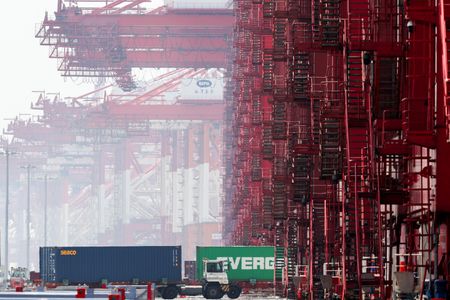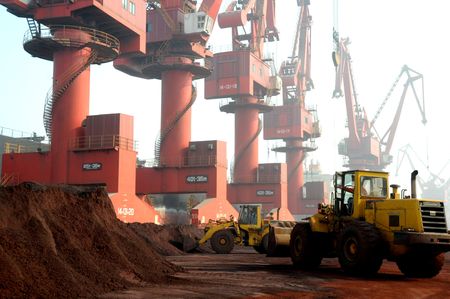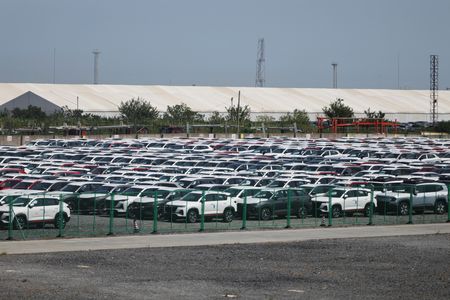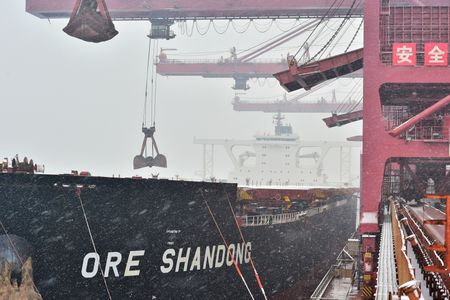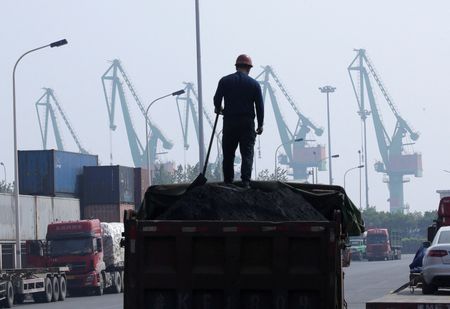(Reuters) -China’s imports of soybeans and crude oil rose in September from a year earlier, while those of coal fell, customs data showed on Monday.
The country’s soybean imports hit the second-highest level on record, driven by strong purchases from South America amid the ongoing trade dispute with the U.S.
China’s export growth picked up pace in September, buoyed by manufacturers finding buyers in markets beyond the U.S. as a tariff deal with Washington remained elusive while investors grappled with the latest salvoes in their trade war.
Outbound shipments from the world’s second-largest economy rose an annual 8.3% last month, customs data showed, up from a 4.4% gain in August and beating a 6% increase forecast in a Reuters poll.
Imports grew 7.4%, against a 1.3% gain in August. Economists had predicted a 1.5% rise.
KEY POINTS:
* Soybeans: September imports at 12.87 mmt, up 13.19% y/y
* Crude oil: September imports at 47.25 mmt, up 3.87% y/y
* Unwrought copper: September imports at 485,000 mt, up 1.25% y/y
* Coal: September imports at 46 mmt, down 3.34% y/y
* Iron ore: September imports at 116.33 mmt, up 11.72% y/y
* Rare earths: September exports at 4,000.3 mt, down 4.32% y/y
Preliminary table of commodity trade data Below are comments from analysts on the commodities data:
COMMENT ON SOYBEANS
ROSA WANG, ANALYST, JCI, SHANGHAI:
“China’s soybean supply outlook has become increasingly secure, supported by strong imports from January to September, a surge in purchases from Argentina during its temporary tax holiday and continued heavy buying from Brazil.”
WANG WENSHEN, ANALYST AT SHANGHAI-BASED SUBLIME CHINA INFORMATION, SHANGHAI:
“September soybean imports reached the second-highest level on record, keeping domestic supply ample. Crushing companies are now pushing to move their stock quickly, which is likely to put downward pressure on soybean oil and meal prices.”
LIU JINLU, AGRICULTURAL RESEARCHER AT GUOYUAN FUTURES, BEIJING:
“The increase in China’s soybean imports from January to September 2025 and the continued high imports in September, are due to several reasons: the stalled trade between China and the U.S., abundant soybean supplies from South America, strengthened domestic demand resilience and a short-term chance to buy low-cost soybeans from Argentina.”
“However, China’s soybean supply still faces some risks, such as how China-U.S. trade talks go, possible production problems in South America caused by this year’s weak La Niña weather and changes in demand for soybean meal in China. These factors are likely to keep affecting soybean imports.”
COMMENT ON IRON ORE
JIANG MENGTIAN, ANALYST, HORIZON INSIGHTS, SHANGHAI:
“We expected to see higher iron ore imports last month as hot metal output stayed high amid healthy margins. And mills’ restocking for the week-long National holiday break in advance also contributed to higher ore imports in September.
“But it beat our expectations to see such a monthly high volume.”
GE XIN, DEPUTY DIRECTOR, LANGE STEEL, BEIJING:
“Iron ore imports in September hit a record high for the period, as higher prices encouraged miners to ramp up shipments to top consumer China.
“Underpinning robust ore imports last month was also stronger demand from China at home and abroad.”
COMMENT ON COAL
FENG DONGBIN, VICE GENERAL MANAGER, FENWEI DIGITAL INFORMATION TECHNOLOGY, TAIYUAN:
“The rapid rebound in domestic prices in the second half of the year has again widened the price gap between domestic and imported coal, making imported coal more competitive. This price advantage is the main driving force behind the swift recovery in import volumes.”
COMMENT ON CRUDE OIL
MUYU XU, SENIOR ANALYST, KPLER, SINGAPORE:
“China’s sea-borne crude oil imports fell month-over-month in September to the lowest level since January, with shipments from Iran hitting the lowest since January.
“The month-on-month decline mainly reflected tight import quotas for independent refineries, which curbed purchases of Russian and Iranian barrels, while narrower arbitrage in June also reduced inflows from Brazil and West Africa, which were loaded in July and August.
“Still, arrivals of Urals crude from western Russia rose as state-owned refiners took advantage of reduced Indian demand in late July and early August, but ESPO shipments from the Far East fell to the lowest since June due to pipeline maintenance at Kozmino that limited September loadings.”
LINKS: For details, see the official Customs website (www.customs.gov.cn)
BACKGROUND:
China is the world’s biggest crude oil importer and top buyer of coal, copper, iron ore and soybeans.
(Reporting by Asia Commodities and Energy team; Editing by Sumana Nandy)

